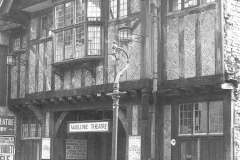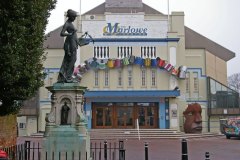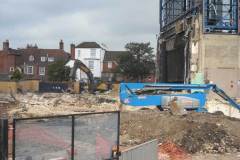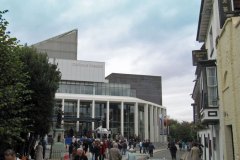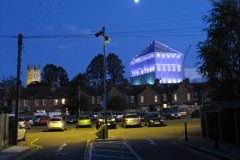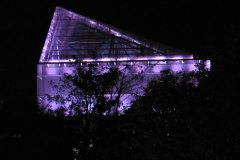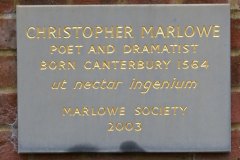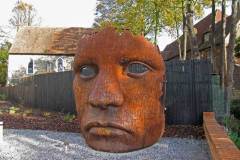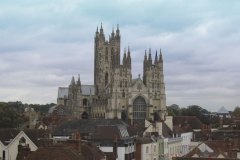The Friars and St Peter’s Lane
Over the past 60 years, Canterbury has enjoyed stage productions in three different ‘Marlowe theatres’, named after the city’s most famous son, Christopher Marlowe. The earliest stood in St Margaret’s Street on land which has since become part of the Marlowe Arcade shopping centre. The Electric Picture Palace cinema stood here from 1909 until demolition in 1926. Its replacement took the form of a neo-Tudor building (Image 1) which housed the Central Picture Company, later the ABC cinema. Twice bombed in WW2, it was purchased by the City Council in 1948 and re-opened in 1950 as the Marlowe theatre. Performances here included some of the best known acts of their day – including Pink Floyd in 1969 and Mary O’Hara, the Irish soprano and harpist, in 1982. Demolition of this first Marlowe theatre in 1982, to make way for the new Marlowe Arcade shopping area, left the city without a major theatre. To fill this gap, the city council purchased a cinema which stood in The Friars. This had been built in 1933 as the city’s only major art deco style building. The cinema conversion resulted in a new Marlowe theatre (Image 2) opened in 1982 at a cost of £5 million, which built a large and loyal following – the Friends of the Marlowe society has over 10,000 members, the largest theatre support group in Britain. By the early 2000s the 70 year old ex-cinema was in need of major refurbishment, and in 2009 the opportunity was taken for a total rebuilding, enlargement and modernisation (Image 3). Archaeological investigations carried out by Canterbury Archaeological Trust in 2010 found remains of a substantial Roman town house, and evidence of the medieval riverfront. The second new Marlowe opened in October 2011 (Image 4), with seating capacity for 1200, bars and amenities on all floors, riverside cafe, and improved access for all. Its night lighting, not of universal appeal, has added new vistas to evening views across the city (Images 5 and 6). The Marlowe Society plaque with Latin tag translating as ‘Genius is like nectar’ (Image 7) could formerly be seen on the access lane from St Peter’s Lane, but now seems to be lost?
What to see:
- an outstanding new cultural building (4,850 sq metres on three floors costing £26 million) which opened on schedule and on budget
- the unavoidable block of the fly tower which rises to 36 metres – according to the architects (Keith Williams) this has been given a cap to emphasise that it ‘pays obeisance’ to the cathedral opposite
- the 8m high colonnade in white cast Dolomite stone
- the stainless steel mesh skin, its surfaces intended to ‘shimmer and sheen with the changing hues of sky’
- the second performance space named The Marlowe Studio, with flexible seating for 150, intended for youth theatre and experimental work
- the Marlowe memorial known as the Lyric Muse – for details see the Christopher Marlowe biography page
- the huge metal mask (Image 8) entitled Bulkhead – this is the work of sculptor Rick Kirby which stood outside the earlier Marlowe Theatre from 2003
- impressive new views of the west front of the cathedral (Image 9) now visible from the upper galleries.
Access: exterior visible all times from street; interior when open for booking and performances
Sources: Image 1 from Kent Messenger Group (1997); see Manners (2011) for all aspects of the theatrical life of the city; also Cameron (2005); Crampton (1998)
for archaeological dig in 2010 by CAT visit the Canterbury Trust website
for details of present new theatre see http://marlowetheatre.com and

